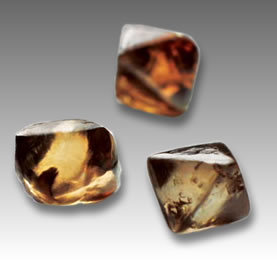Champagne Diamonds
Introduction to Champagne Diamonds

If you've ever wondered what champagne diamonds are, you're not alone. These gemstones, known for their warm, golden hues, have gained popularity in fine jewelry. Champagne diamonds are a unique variety of natural diamonds that come in shades ranging from pale yellow to rich, deep brown, often resembling the color of the famous sparkling wine.
Unlike traditional white diamonds, champagne diamonds are celebrated for their distinctive color and are often chosen by those seeking something unique and stylish.
Grading and Value
The grading of champagne diamonds focuses on their color intensity, with darker shades generally fetching higher prices.
For colored diamonds or fancy-colored diamonds, the intensity of color is the key factor, while clarity, brilliance, and fire play a lesser role. In fact, many fancy champagne diamonds have sold for impressive amounts. For example, at a Sotheby’s auction in Hong Kong in 2023, a remarkable 6.01-carat champagne diamond known as the "Golden Empire" went for over $3 million. The color of fancy-colored diamonds is assessed based on hue (the characteristic color), tone (lightness or darkness of color), and saturation (depth or strength of color).
Diamonds can occur in nearly any color, but yellow and brown are the most common. In the diamond trade, stones with yellowish or brownish tones were once seen as "low colors." At one point, brown diamonds were mainly used for industrial purposes.
History and Marketing
Brown diamonds started to be marketed seriously after the Argyle diamond mine in Australia opened in 1986. Until its closure in 2020, the Argyle mine produced about 35 million carats of diamonds each year, nearly a third of the world's total. However, around 80% of those diamonds were brown. This created a challenge: a large supply with limited demand.
To address this, the jewelry industry used two approaches. With the large supply, brown diamonds were priced lower, often about 30% less than white diamonds. They also introduced appealing color names like "champagne" and "cognac" instead of just "brown diamonds" to draw in more buyers.
Diamonds are also connected to certain meanings and powers which you can discover here.
Properties of Champagne Diamonds
Champagne diamonds may cost less than white diamonds, but they are natural diamonds and show all the classic diamond qualities: exceptional hardness (10 on the Mohs scale), a very high refractive index (2.417 - 2.419), and outstanding fire.
It's worth noting that champagne diamonds are completely untreated. Their brown and golden hues come purely from nature, unlike some vivid diamond colors created through irradiation or high pressure/high temperature treatment.
Frequently Asked Questions
What are champagne diamonds?
Champagne diamonds are a variety of natural diamonds with warm, golden hues ranging from pale yellow to deep brown, resembling the color of champagne.
How are champagne diamonds graded?
They are graded primarily based on color intensity, with hue, tone, and saturation being key factors. Darker shades often have higher value.
Are champagne diamonds treated?
No, their colors are entirely natural and untreated, unlike some other colored diamonds that may undergo treatments like irradiation.
Why were they renamed from brown diamonds?
To make them more attractive to consumers, the industry introduced terms like "champagne" and "cognac" after the Argyle mine produced a large supply of brown diamonds.
How do champagne diamonds compare to white diamonds?
They are more affordable, often 30% less expensive, but share the same hardness, refractive index, and fire as white diamonds, while offering a unique color.

